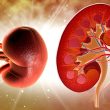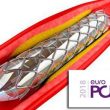Sirolimus-eluting stents with biodegradable polymer did not offer better outcomes compared with instant-classic (and undoubtedly valid) everolimus-eluting stents with durable polymer such as Xience. New-generation drug-eluting stents (DES) offer better outcomes than first-generation devices after a 10-year follow-up, according to the ISAR-TEST 4 trial presented at the American Heart Association (AHA) Congress Scientific Sessions and published...
EXCEL Sub-Analysis: Angioplasty vs. Surgery in Chronic Renal Insufficiency
EXCEL patients with chronic kidney disease and left main coronary artery disease have higher rates of acute renal failure and other events compared with the general population. However, acute renal failure was less frequent with angioplasty than with surgery, while other events such as death, stroke, or infarction at 3 years were similar for both revascularization...
TCT 2018 | ABSORB IV: Much Life Left for Bioresorbable Scaffolds
Previous studies have documented higher rates of adverse events with bioresorbable scaffolds (ABSORB) compared with metallic drug-eluting stents (DES). However, these studies included lesions smaller than recommended for these scaffolds and a suboptimal implantation technique. The ABSORB IV study, presented by Dr. Stone at TCT 2018 and published simultaneously in The Lancet, randomized patients to polymeric everolimus-eluting scaffold Absorb...
TCT 2018 | TALENT: Ultrathin Struts and Bioresorbable Polymer at the Lowest Possible Cost
This study assessed the Ultra-thin Strut Bioresorbable Polymer-based Coronary DES (Supraflex) against the Xience, with special emphasis in the cost-benefit ratio. It included a population of 1435 all-comers from 23 centers in 7 European countries, randomized 1:1 (720 Supraflex and 715 Xience). Primary end point was a composite of cardiac death, target vessel myocardial...
Should Sex Be Taken into Account with Left Main Coronary Artery Revascularization?
The EXCEL trial did not find the sex of patients with left main coronary artery disease to be an independent predictor of adverse events after revascularization. However, women who underwent angioplasty had a trend towards worse outcomes, a finding that might be related to comorbidities and somewhat increased chances of peri-procedural complications. In its formal...
New Ultra-Thin-Strut DES: Do They Outperform Second-Generation DES?
The new drug-eluting stents (DES) equipped with ultra-thin struts are showing a lower risk of target lesion failure as a result of lower rates of acute myocardial infarction and similar rates of revascularization, according to this meta-analysis soon to be published in Circulation. Such a difference is evidenced at a 1-year follow-up when compared with...
EuroPCR 2018 | 2nd and 3rd-Generation DES for Bifurcation Lesions: Nothing New Under the Sun
This study aimed to assess the outcome of Culotte stenting with newer-generation drug-eluting stents (DES) in Medina 1, 1, 1 bifurcation lesions. The 2nd-generation device used was permanent-polymer everolimus-eluting stent Xience, a device for which there is comparatively plenty of evidence available. Alternatively, the 3rd-generation stent used was thin-strut abluminal bioresorbable-polymer everolimus-eluting stent SYNERGY. Patients with...
EuroPCR 2018 | DESSOLV III: Bioabsorbable vs. Durable Polymer at 2 Years
Most drug-eluting stents are coated by a polymer that is used to contain the antiproliferative drug. Once the drug is released, the polymer remains in place and its presence has been associated with inflammation, restenosis, and neoatherosclerosis. The MiStent device features a polymer that becomes bioabsorbable once the drug has been released, which could, theoretically,...
Quality of Life Between Surgery and Angioplasty for the Treatment of Left Main Disease
In recent years, angioplasty with drug-eluting stents (DES) has emerged as an alternative to myocardial revascularization surgery in patients with left main coronary artery disease. Both European and American guidelines offer a Class IIa recommendation for left main coronary artery (LMCA) angioplasty in selected patients. The EXCEL (Evaluation of Xience Versus Coronary Artery Bypass Surgery for...
ABSORB III: after 3 Years, the Bioresorbable Scaffold is Still a Disappointment
Courtesy of the SBHCI. The 3-year outcomes of the ABSORB III trial, which randomized 2008 patients 2:1 to an everolimus eluting bioresorbable scaffold (1322 patients) vs. a metallic stent with permanent everolimus eluting polymer (686 patients), was published with low profile and great disappointment. Primary end-point, a composite of target vessel failure, occurred in 13.4% of patients receiving...









